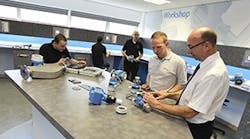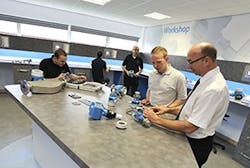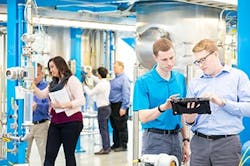Process instruments have been digital (smart) for many years. In fact, microprocessor-based measuring devices for flow, level, pressure, temperature, etc., have been available since the 1980s. However, a vast majority of units purchased and installed still rely on the 4-20 mA analog output of the process variable, with the digital interface completely ignored.
This article is part of our monthly Automation Zone column. Read more from our monthly Automation Zone series.
Smart instruments can provide a wealth of information via HART, EtherNet/IP, and other digital interfaces, but most plants don’t use these communication protocols. And there’s even a surprising percentage of instruments with no outputs connected and users relying only on displayed values as a visual indication.
In many cases the problem is a skills gap and a lack of training for the plant technicians who are expected to work with these smart instruments. Training is essential as a plant proceeds with digital transformation (Figure 1), whether that training takes the form of formal internal onboarding and mentoring, informal sharing of institutional knowledge, online learning, or classroom instructor-led events (or some combination of these).
Leading buzzwords in the process industry include Industrial Internet of Things (IIoT), digitalization, Industry 4.0, edge computing, and the cloud. And while a lot of people are getting excited about these terms, many are not sure how to implement the associated technologies. In addition, are so many solutions being touted nowadays that it can be overwhelming to evaluate, compare, and choose from among them.\
Figure 1. With instrument training, students learn how modern instruments provide digital data to IIoT cloud services.
On top of that, there’s an abundance of new mobile apps being released, an explosion in the number of WiFi, Bluetooth and RFID connections available, a growing portfolio of Ethernet-connected devices, IO-Link, etc., plus new handheld Windows 10 tablets that are intended to be an integral part of the evolving IIoT ecosystem.
Control engineers working on new designs also face a heightened need to think beyond how processes can be made to work on Day 1 when commissioning is complete to how a “system” can evolve and improve.
A good place to start is by learning what the instrumentation currently installed in their plants can do. The data in those instruments reflect the “things” in the IIoT. That is, the diagnostic data, status, process value, calibration data and other metrics a modern instrument can provide often form the basis for maintenance and process management decisions made by sophisticated software higher up in the digitalization chain.
Learning the capabilities of smart instrumentation is thus the starting point before one can proceed to optimizing use of more complex software applications such as a computerized maintenance management systems or other asset management systems or a distributed control system. The good news is most plant engineers and technicians already know how flow, level, pressure, and temperature instruments work to provide a process value; they just aren’t familiar with all of these instruments' capabilities.
Training should include working on actual smart instrumentation connected to an IIoT system (Figure 2). This way, students can see how the data is generated, how it’s transmitted, what kind of software processes it, and what the results can be.
Figure 2. It’s vital to see smart instruments in action and have a chance to gain hands-on experience applying principles learned in the classroom.
Getting ready for the IIoT
Many companies look for easy targets for cutting expenses, and training programs have often fallen victim to this short-sighted approach. But when developing a long-term strategy for IIoT adoption, it's important to remember that successful adoption of digital technologies and associated new processes will not happen without the right skill sets in place.
Instrument training makes engineers and technicians aware of how modern digital technology works. They can evaluate the installation of new devices and the use of the data generated from them to improve operations. With this preparation, the plant will be well prepared to implement IIoT installations.
Low-cost flow, level, pressure, and temperature monitoring and analysis devices are available today, some for less than $500 per measuring point. These can be a worthwhile investment when older devices fail, allowing plants to upgrade to a more capable smart device instead of just ordering an exact replacement.
- Read "Sick instruments: Seeking great performances from your assets? Don't neglect instrument maintenance"
Development is occurring at a dizzying pace. Some of the newest devices are smarter now than they were just one or two years ago. And innovations never before imagined, like self-calibrating RTD temperature sensors or flowmeters and level measuring electronics with self-monitoring and verification capabilities, are hitting the market.
Jerry Spindler has been training manager for customer and field service training at Endress+Hauser since 2012. Previous positions at Endress+Hauser were in product marketing and business development. Spindler has an MBA and a BS in electronics and mechanical technology.
But this capability isn’t available to you unless you know that these devices exist and can be implemented in your workflow.
IIoT and digitalization will soon be a competitive necessity. With proper training, including seeing new tools in action during training or at a trade show, users can realize a path toward adoption.
IIoT and digitization can be daunting to understand, especially in plants that aren’t taking advantage of the digital capabilities of instruments they’ve been using since the 1980s. Modern instruments provide the “things” in the IIoT, and instrument training will acquaint engineers and technicians with how these instruments work. Such training is readily available from most instrument manufacturers.


